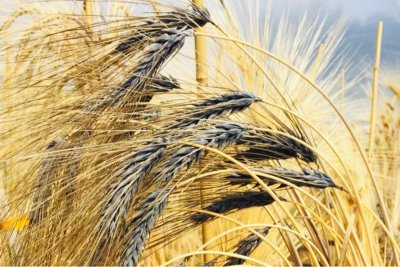Sustain / Real Bread Campaign / Articles
Barley vous?
Professor Wendy Russell is leading research at the University of Aberdeen’s Rowett Institute into the potential benefits of a barley renaissance.

Barley (Hordeum vulgare) was one of the earliest cultivated plants and continues to play an important role in modern agriculture. Current barley production is around 150 million metric tonnes worldwide, making it the fourth largest grain crop produced after maize, wheat and rice. The European Union is the largest producer of barley, accounting for 34% of global production, while in the UK it is the second largest arable crop (by area) after wheat.
Barley was originally domesticated as food for people but this use has declined dramatically. Approximately two-thirds of the barley now grown in western agriculture is fed to livestock, with a further 30% being malted for the distilling and brewing industry.
First harvest
Barley was domesticated around 10,000 years ago from Hordeum spontaneum, the wild relative of our modern varieties. There is strong evidence that barley was first cultivated in ‘The Fertile Crescent’, which stretches from north Africa into the Middle East, where it can still be found today. Recent genetic and phylogenetic analyses have shown that Tibet was also an early domestication centre for barley. This provides more evidence that ‘The Silk Road’ played an important role in gene flow between eastern and western barley varieties.
Examples of traditional barley breads include the North African khubz and bazin. The Orcadian Bannock is still produced today from bere (pronounced bare/bear), an ancient Scottish landrace barley thought to have been introduced by the Vikings.
Looking to the past to feed the future
Barley thrives in the UK and the environmental adaptability of various cultivars compared to other cereals might become a driver for a global resurgence as a food crop. If this use of barley is to increase, priorities will include not only resilience to mitigate against unpredictable seasonal and annual variations in weather and effects of rising atmospheric CO2 levels but also ensuring high nutritional quality. The good news is that the varieties with environmentally beneficial traits might also be of benefit to our health. There is also scope to produce varieties with higher and more stable yields, as well as better resistance to pests and weeds.
Ancient barley landraces could provide the answer. We have been exploring the nutritional and health benefits of barley lines that have been produced by cross-breeding with ancient Asian landraces, namely Tibet, Hindukush, Tamalpais and Co6. Like the original wild barley grown in The Fertile Crescent, these have two rows of seeds on the head and produce grain in a range of colours; purple, black, brown and yellow.
Potential benefits
There are number of potential advantages of these colourful barleys. One of the most important is that they are higher in beta-glucan than the majority of varieties currently grown in the UK. Beta-glucans are soluble, non-starch polysaccharides that occur naturally in cereals. The European Food Safety Authority has approved a health claim that barley beta-glucans can help to reduce blood cholesterol, in particularly low density lipoprotein (LDL) cholesterol (AKA ‘bad’ cholesterol), which is a risk factor in the development of coronary heart disease. It has been shown that consumption of a minimum of 3g of barley beta-glucan a day can deliver this benefit. This is the amount in approximately 65g of black barley (Tibet x Hispanic) bread – a thick slice or a couple of thinner ones. We are now investigating in human studies whether these coloured barleys can also help to reduce blood glucose. Lowering blood glucose as well as blood cholesterol are major targets in the prevention of metabolic diseases.
Unlike many barleys bred for distilling and brewing, these lack a protective hull, an inedible husk that has to be removed during processing. Hull-less grains are, therefore, easier to process, meaning a more economically viable field-to-fork approach. De-hulling also means that a rich source of fibre and micronutrients is lost, while hull-less varieties tend to have more fibre and micronutrients incorporated into the edible grain.
The colours derive from a range of phytochemicals (plant compounds) including anthocyanins and hydroxycinnamic acids, many of which we think contribute to the prevention of non-communicable disorders such as type 2 diabetes mellitus and cardiovascular disease. Some phytochemicals are natural pesticides, so these lines might grow better in organic farming systems. They might even play a role in natural food innovation by replacing artificial colours.
Given the credentials of these barley lines, we believe that they have huge potential in contributing to meeting our health and climate targets, as well as diversifying our diet and agriculture. We can all play a role in making better choices when it comes to grain selection. However, this can only happen if these varieties are available to be grown in our fields, and there is no point increasing supply without an increase in demand. As bread is an important staple food, the bakery sector and their customers are in a position to have a major influence, so this is a call to action to bake and eat better and more colourful barley!
Be a barley baker
You can download a free booklet of recipes for baking and cooking at home with barley and oats (and order print copies) from The Rowett Institute website.
Originally published in True Loaf magazine issue 56, October 2023.
Bere with us
Professor Wendy Russell will be speaking during Real Bread Week at The Scottish Festival of Real Bread on Saturday 24 February 2024.
Published Tuesday 13 February 2024
Real Bread Campaign: The Real Bread Campaign finds and shares ways to make bread better for us, better for our communities and better for the planet. Whether your interest is local food, community-focussed small enterprises, honest labelling, therapeutic baking, or simply tasty toast, everyone is invited to become a Campaign supporter.

